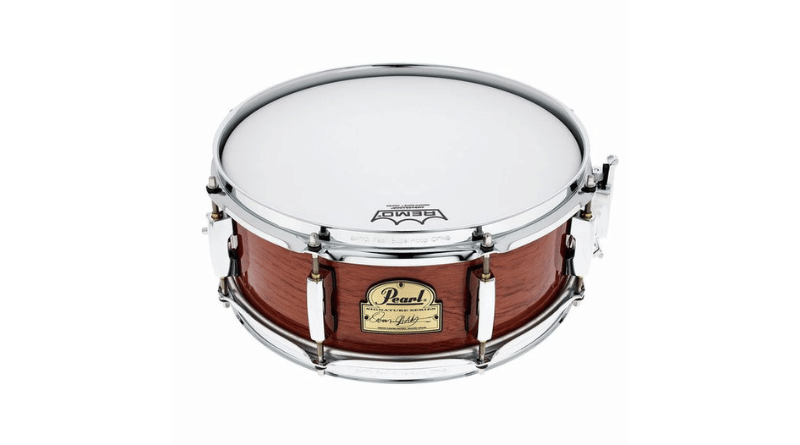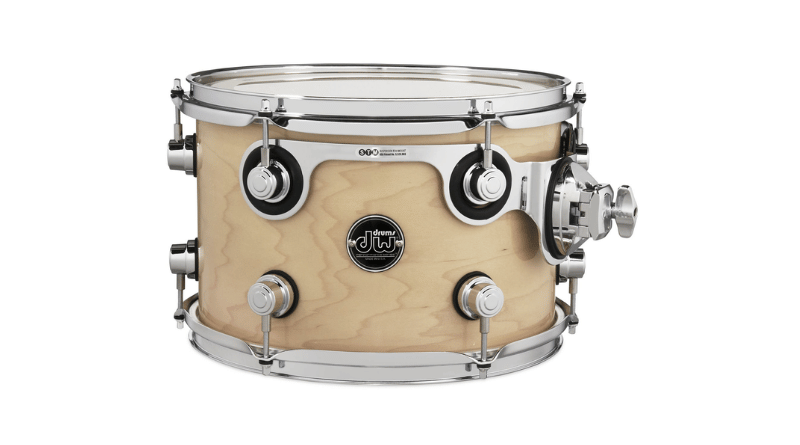Drums fall under the category known as unpitched percussion. While they don’t have any assigned musical notes, they can be tuned to create good sounds.
Drums can definitely be out of tune, but not in the same way as melodic instruments. When a drum is out of tune, it means that the drumhead isn’t perfectly tightened across all the lugs, and that causes the drum to have an unpleasant sound.
Here’s a quick guide on knowing if your drums are out of tune. We’ll explain what to look for and how to fix it.
Contents
How To Know When a Drum is Out of Tune
Overtones
The first sign of knowing if a drum is out of tune is hearing unpleasant overtones. When all the tension rods around the drum are perfectly matched, the drum will produce the fullest and most round sound possible. When something is off, you’ll hear harsh frequencies every time you strike the drum.
These overtones can be handled by applying muffling to the drum, but that will also take away a lot of the tone. So, the first thing you should do when you hear ugly overtones is tuning the drum without having any muffling applied to it.
Just note that all drums have overtones. It’s just the very harsh ones that indicate a tuning issue.
Loose Tension Rods
Another clear sign of a drum being out of tune is having loose tension rods around the rims. As we said earlier, the tension rods need to be perfectly matched for the drum to sound good in most cases.
The more you strike the drum, the more pressure gets put on those rods, and they often come loose.
It can be very easy to miss this, as it’s difficult to see when a tension rod is loose or not. So, you should just regularly check all your tension rods to see if any of them are wobbling.
It’s mostly the tension rods on the batter side that come loose compared to the resonant side, so you won’t need to check the bottom rim as often.
Pitch Shifts
The last sign to look out for is pitch shifting. This is when you strike the drum and hear a sound, and then the pitch raises or lowers halfway through that note being played. It typically lowers, so you hear a full sound at first, but then it goes flat.
Make sure to strike the drum at the center to hear this. When you strike the drum near the edges, the sounds are often quite weak anyway.
You also won’t hear pitch shifting when the drums are muffled, so you’ll need to play them without any dampening on them to check for this.
Which Drums Go Out of Tune the Most
Snare Drums

Snare drums are played the most, so they naturally go out of tune the most.
Kick drums also get played as much as snare drums, but they always have a bit of dampening, so it’s difficult to hear if they’re out of tune. They also have much larger tension rods that don’t loosen as often.
If you play lots of rimshots, the tension rods at the bottom of the snare are more likely to loosen. This is the biggest problem that most drummers have. So, you just need to tighten those every now and then to keep the snare in tune.
12-inch Rack Toms

12-inch rack toms are undoubtedly the most difficult drums in a set to tune. There’s something about that size that makes it tricky to get all the tension rods to work well together. That’s why you’ll find a lot of drummers opting to only use a 10-inch rack tom with two floor toms.
Once you get the 12-inch tom in tune, it may just go out of tune a lot quicker than your other toms. Again, it’s just a weird size.
It usually helps to apply some strong dampening on it. Placing cotton balls inside the shell also works incredibly well.
Drums with Single-Ply Drumheads

Thinner drumheads go out of tune a lot faster than thicker drumheads. There are quicker vibrations when you strike a thin head, and that affects the tension rods more.
If you’re a hard-hitting drummer, we highly suggest that you stick to playing two-ply drumheads. Drummers who hit hard on single-ply heads have a very hard time keeping their drums in tune.
While you get the most tone out of single-ply heads, keeping those good tones coming at all times can become a chore. If you’re happy to tune your drums very often, then the sacrifice may be worth it.
How Often Should You Tune Your Drums?
It depends on how often you play gigs, what type of drum kit you have, how hard you play, and what weather environment you’re in.
Some drummers can go up to a month without tuning their kit, while others tune their kit every single time they play it.
If you’re playing a gig and you want the best sounds possible, you should do a deep tuning just beforehand. Otherwise, it’s a good idea to give your drums a few tweaks every so often in the practice room.
If you hear something really bad from a particular drum, then you should take the drumhead off completely and give the drum a fresh tune.
Something to note is that heavily muffled drums don’t need to be tuned as often as open drums.
Do Cymbals Go Out of Tune?
Cymbals don’t go out of tune, but their tones do change over time. As grime, dust, and age get to a cymbal, its sound starts to mature.
Most drummers love the sound of older cymbals, as they tend to become a lot more dynamically responsive with age.
Final Thoughts on Drums Being Out of Tune
Tuning drums is something that every drummer should know how to do. While drums don’t go noticeably out of tune like melodic instruments, they do develop unpleasant sounds when all the tension rods aren’t even.
It’s a good idea to check your drum tones often. If they’re not what you want them to be, you can use a drum key to tune your drums to get better tones. It’s also incredibly helpful to have a drum tuner.